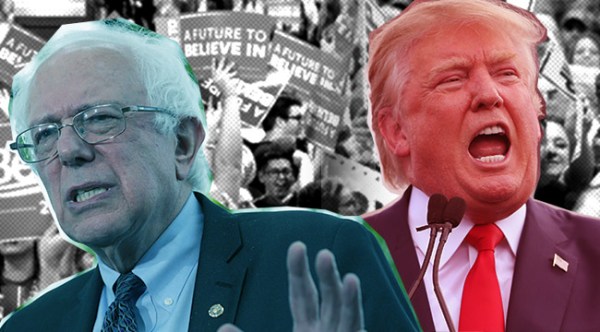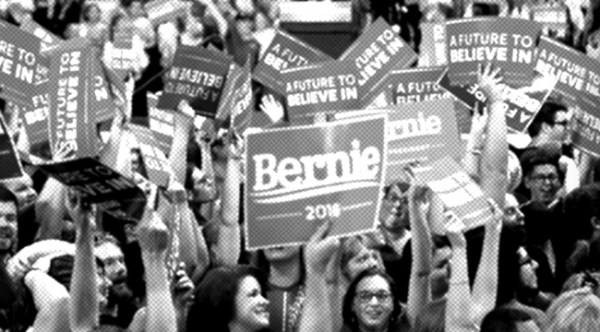
Hillary Clinton has been declared a lock for the Democratic nomination by the AP. The Trump v. Clinton showdown that we all assumed was coming looks imminent. And yet, when we look back on the 2016 primaries, what will be remembered most will be the people–galvanizing, headline–grabbing, sometimes–violent movements of Donald Trump and Bernie Sanders. Something about these party outsiders captivated the public consciousness and brought listless citizens back to their respective parties.
At first glance, Trump and Sanders fans couldn’t be more different. Not only would they be likely to self-identify as polar opposites, but they’d also hate the idea of being compared. And yet, it’s tough to deny that both candidates built their respective movements on a platform that hoped to speak for the voiceless and break down the D.C. power structure.
With that in mind, we asked Uproxx News editor Kimberly Ricci and economist Thad Beversdorf to analyze the overlap between the two movements — both in what they want and how they perceive themselves. Their thoughts overlap at times and diverge at others, leaving plenty of room for conversation.
Sanders: The Champion Of The Disenfranchised Dem

Kimberly Ricci: We’ve seen Trump make outrageous claims only to have voters embrace him more — Sanders has a similarly intense, almost cultish fanbase. He appeals on an emotional level to the disenfranchised voters who once found hope in the Occupy Wall Street movement. His impassioned goals may not be practical in terms of execution, but his supporters hold the ultimate faith that a Sanders administration could ease their pain. These are the voters who are burdened with student loan debt and are distrustful of “the system.” Their economic frustrations and jaded view of where political and banking interests overlap align perfectly with Sanders’ promises to be tough on Wall Street and reform campaign finance.
To marginalized Democrats, Sanders is a true outsider, and he’s shifted the party further to the left. So, although the Bern won’t win, he’s left a legacy for the foreseeable future. Sanders has made it okay to express a desire for a more “socialist” leaning economy and proven that fighting the powers-that-be has mainstream appeal. That’s the major similarity here, Sanders and Trump reach voters who feel left behind by their government.
Thad Beversdorf: The men are obviously different — I’m interested in discussing how the two movements are similar. The number one demographic for Bernie is not illegal immigrants looking for a free hand out (as a Trump supporter might glean from their chosen TV shows), but youth. Depending on which poll you look at, Bernie is taking upward of 65% to 75% of those in the 18 to 29 years old range. That’s an incredible statistic. And remember, millennials are the largest demographic in America today (yes, larger than the baby boomers). But let’s zero in on why this demographic has become a movement.
According to a recent Pew Research Center analysis of census data, “In 2014, for the first time in more than 130 years, adults ages 18 to 34 were slightly more likely to be living in their parents’ home than they were to be living with a spouse or partner in their own household.” Pew goes on to highlight that by 2014, 32.1% of this demographic were living at home with their parents, more than the 31.6% living with spouses or partners.
Why? It starts with income and debt. In 2000, nearly 80% of those in their early to mid-20s were working. Today that figure is down to 70%. That is an incredible drop in just a 15-year period.
You’d have to go back to 1970 to find a worse labor participation rate for this age group.
And let’s have a look at actual weekly earnings for the Bernie demographic.
About $500 a week, or $26,000 per-year in income — slightly above the Federal guidelines poverty level for a family of four (and they wonder why millennials aren’t starting families).
But what about debt? The next chart shows the total amount of student debt held by those under 30 years old — about one-third of all student debt as per a N.Y. Fed study.
The amount of debt held by those under 30 has more than doubled over the past 10 years. It doesn’t take a rocket scientist to figure out the problem: Student debt has been rising like the sun while incomes have barely budged. As a result, millennials are in deep sh*t fiscally speaking. And so what better candidate to get behind than a man promising to lift the financial burden and place it squarely on the shoulders of the .1%? Makes perfect sense.
Trump: The Ally Of The Disgruntled Republican

Kimberly Ricci: Trump surrogate Sarah Palin recently summed up his appeal at a San Diego rally. While explaining why Trump succeeded as the nominee, Palin shouted, “The status quo has got to go, the permanent political class has failed us.” Palin — who assured attendees that Trump would protect people from special interests — nailed it.
Trump’s rise has everything to do with the failure of the Republican establishment to understand its own voting base. Trump, who holds himself out as a self-made man, appeals to blue collar households who have found themselves underemployed. They work their tails off regardless of their education-level (remember when Trump theatrically shouted, “I love the poorly educated!”?), pay taxes, and would rather not live off the public dime. Even after the most outrageous Trump statements, his followers say, “He’s saying what I’m feeling” even when those feelings seem divisive. They embrace how their guy doesn’t take sh*t from the powers that be.
The paradox here is that Trump is decrying the very business, trade, and tax practices that he’s openly admitted to following. Still, his voters believe in his mission and trust that he can help them. They love that he seems beholden to no one but himself.
Thad Beversdorf: Let’s take a close look at who is really backing Trump. Not too long ago, I discovered that there are 29 states that have lost total manufacturing income since 2007 (or just prior to the financial crisis). This essentially means that there are less manufacturing jobs in those states today than before the crisis. Of those 29 states, 27 had completed their Republican primary elections while there were still at least two candidates in the race (meaning while Trump still had to fight for votes). Now get ready, this is the kicker:
Up to this same point in time, Trump had racked up 26 wins. Of those 26 wins, 25 were states that had lost manufacturing jobs. This means that of the 27 states that lost manufacturing jobs and completed their primary election, 25 of them went to Trump. That’s 93%. Furthermore, 96% of Trump’s wins (25 of 26) were in lost manufacturing states.
What this suggests is that it isn’t the wealthy white bigots driving the Trump Train (as a Sanders supporter might glean from their chosen TV shows), but struggling middle and lower middle class households that have awakened to the fact that “the system” is working against them. But for this demographic, jobs, not socialism, is the answer. These voters had good jobs — so it’s what they know and it is part of their identities and egos. For them, taking a government subsidy would feel as though they’ve failed their families.
So What?
Kimberly Ricci: Sanders and Trump fans both believe their candidate’s respective platforms. The Sanders contingent points to his decades participating in sit-ins and marches for his causes. Meanwhile, Trump’s supporters aren’t worried about his tax-return disclosure or Trump University, they believe in his stated goals. Even Trump benefitting from the 2008 financial crisis hasn’t hurt him with his base. When Trump raves about craving relief for the downtrodden middle class, his voters cling to that message.
Both candidates make promises that may never come to fruition, but none of that matters. While totally different men with opposing social views, Trump and Sanders gained trust from people who feel abandoned by the powers that be. They want to be on the “right side” of their favorite candidate’s theoretical re-making of the democracy.
Thad Beversdorf: So Sanders supporters are debt-ridden and jobless under-30s who are looking to socialism to lift the burden, and Trump supporters are over 30 and see jobs as a part of their personal identity. We ought not lose sight of the fact that both of these groups, nay, both of these movements share the very same mother: Desperation. The crowds are borne of a desperation of not only being left behind, but the fear that if the system doesn’t change dramatically and imminently, hope for the future will also be lost.
Below is evidence that the two party system truly is the haves and the have nots, not the right and left. Have a look at the following truth about the “Trickle Down” policies.
What becomes painfully clear is that bankers and corporations have reaped wildly while the average American has gained nothing. The system is designed by and for the plutocrats. They’re using the right and left to divide and conquer the plebs.
